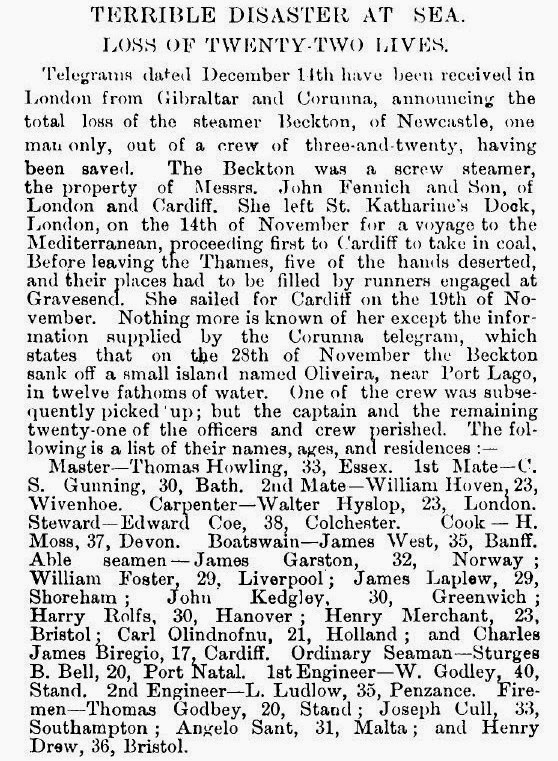Sturges Bourne Bell was born
in Port Natal on 17 July 1852 to Captain William Bell and his wife Mary Ann nee
Caithness. Apart from his birth and baptism, records concerning Sturges
were scarce.
However, an unusual pair of
forenames can be an advantage when tracing an ancestor - especially in that mine
of information, contemporary newspapers. So it proved in the case of Sturges
Bourne Bell.*
Apparently he stayed with family tradition and became a mariner. In
1873 he turns up as crew member on the collier Beckton sailing from Cardiff to Malta,
when on the night of 28 November this screw steamer struck a sunken reef in
heavy fog about three miles off the coast of Spain. There was a strong gale
whipping up the sea and within minutes it was evident that the ship would soon
break up.
The crew launched a lifeboat
but it was immediately swamped, with the loss of eleven men. An attempt to
launch the jolly-boat also failed. Several seamen including the mate leapt into
the waves or were washed off the vessel. Only the captain and Bell were left on deck. Bell
managed to get a lifebelt to the captain, who could not swim, but the captain was
swept away and Bell
then decided to try and make for land, stripping off all his clothing except
his shirt.
As he swam he called out for
any possible survivors in the water and was answered by the mate, the two men
swimming together for some distance. When the mate’s strength began to fail,
Bell found him a plank and the mate clung to this but was unable to continue,
asking Bell to go and see his wife and five children to tell them how he’d
died. Later the mate’s body was washed up, still clasping the plank. The bodies
of seven other seamen and that of the ship’s cook followed.

Bell reached the shore alive, though severely bruised and
cut from his passage through the reef. He might have bled to death if he hadn’t
torn his shirt into strips and bandaged himself as best he could. After four
hours in the sea he lay exhausted and helpless on the beach until eventually
found by two young women and assisted to the nearest village. The local
inhabitants tended his wounds and Bell
afterwards spoke warmly of their kindness. When he was sufficiently recovered they
sent him on to Corunna where the packet Onward took him on board. Bell was duly landed at Plymouth, the Shipwrecked Mariners’ Society
offering him a temporary refuge at the Sailor’s Home.
It had been a dramatic
wreck, with over 20 lives lost, Bell
being the sole survivor. He seems to have acquitted himself well and his
actions in assisting others showed some heroism. Accounts were published in
several British newspapers, identifying him as Sturges Bourne Bell, aged 20,
from Port Natal. He is variously described in the reports as Ordinary Seaman
and Able Seaman.
 |
Crew members listed: Central Press 17 Dec 1873 |
According to one news column, when Bell left Plymouth
he headed for London
but at that point he drops out of sight. It hasn’t yet been established whether
his family in Natal
ever saw him again or heard about the shipwreck and his miraculous escape from
the deep.
As Sturges Bourne Bell
sailed away from the shores of Spain,
perhaps he whistled the old Navy refrain:
‘Farewell and adieu to you, Spanish Ladies,
Farewell and adieu to you, ladies of Spain;
For we've received orders for to sail for old England,
But we hope in a short time to
see you again.’
 |
Spanish ladies: Raquel and Manuela by Sir William Russell Flint
|
 |
Lloyd's Register entry 1873/74 for the Beckton; here her captain's name
is given as Howley; she was built in Newcastle in 1869, and sailed between
London and Mediterranean ports; it is noted that she was wrecked. |
* For more on the origin of
his forenames:
Acknowlegement
Tom Sheldon



































